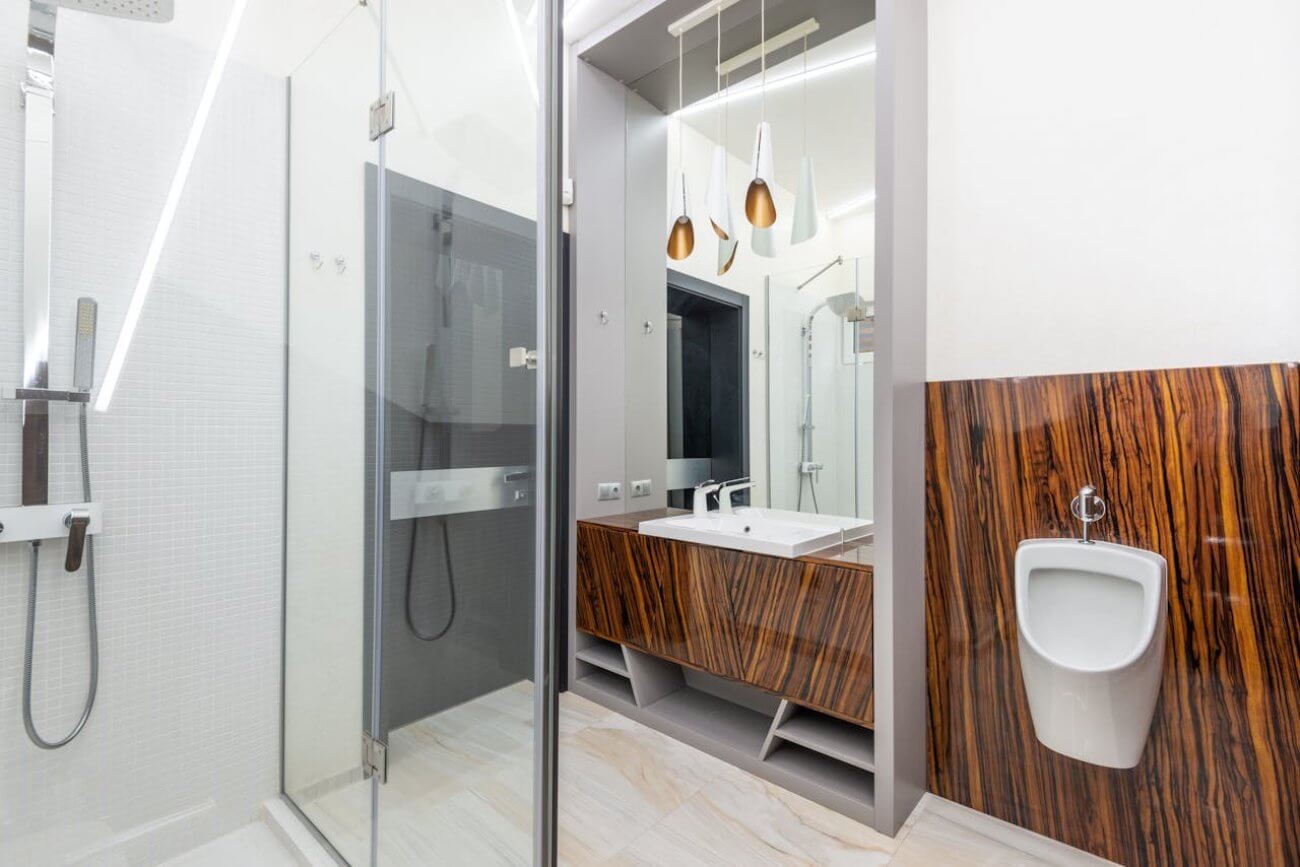
A urinal at home is a solution that is gaining more popularity year after year, especially in modern bathrooms. Although they are mainly associated with public toilets, they can also be found in private bathrooms. Read today about the benefits this solution brings. Discover the advantages of this specific sanitary fixture. See if it's worth deciding on installing a urinal in your home toilet.
What will you learn from this article?
Are you wondering if a urinal at home is truly a functional option? In this article, you will discover the benefits of installing this ceramic fixture in your home bathroom and how to choose the best model for yourself. You will also learn:
- What are the advantages of having a urinal at home?
- What types of urinals can be distinguished?
- How to properly install this ceramic fixture to ensure it works flawlessly?
- What should be taken into consideration when choosing a urinal?
Thanks to this information, you will make an informed decision and learn how to fully utilize the potential of this modern sanitary fixture.
Urinal at home – practicality and savings
The decision to install a urinal at home is often an individual matter. Initially, you should consider several key aspects that make this bathroom fixture beneficial. First of all, it takes up little space, making it possible to install even in small areas. It's important to know that the urinal models available on the market have been designed with functionality and aesthetics in mind.
Urinals in private homes are usually mounted directly on the wall, making them perfect for any bathroom. Thanks to their special design, they are easy to keep clean, which definitely facilitates their daily use. You should also consider the water savings offered by modern urinals. Compared to a traditional toilet, they use significantly less water during flushing, which directly translates into lower bills.
Wall-mounted urinals and beyond – discover the types of urinals!
There are many types of urinals available on the market, which differ in both functionality and design. One of the most popular solutions is the classic wall-mounted urinals, intended for direct installation on the wall. They take up little space and are perfect for public toilets with higher traffic.
Standing urinals are also frequently chosen, which are more stable and can serve as an elegant addition to a home bathroom. Moreover, corner models and urinals with a touchless flushing feature are increasingly used.
This specific bathroom ceramic can also be selected based on the water supply and cleaning method. Traditional variants are equipped with a manual button, but modern waterless urinals are also available, eliminating the need for flushing. This is not only an ecological but also a hygienic solution that minimizes the risk of contact with bacteria while ensuring easy cleaning.
There are also models with a smart sensor that automatically triggers the flush after use. The choice of the right urinal thus depends on the user's preferences and the bathroom's specifics.
Which urinal to choose?
The best choice for a home bathroom would be a urinal that combines functionality with aesthetics and adapts to the individual needs of users. Firstly, checking the installation method is essential – urinals can be installed in various ways, and the appropriate choice depends primarily on the room layout and aesthetic preferences.
Secondly, the material used in the manufacturing process is crucial. A standard urinal can be made from various materials like ceramics or stainless steel. It is also important to pay attention to additional features, such as height adjustment or built-in water-saving systems.
Installing a urinal in the bathroom – what should you know?
Installing a urinal at home is a relatively simple process, although it requires proper preparation and planning. Usually, it is mounted on the wall at a height of 60 to 80 cm from the floor. It's also worth considering the appropriate distance from other sanitary fixtures, such as the sink or toilet, to ensure comfort while using the bathroom. Additionally, its appearance is significant, for example, models with streamlined shapes are best for small spaces in private bathrooms.
Installing a urinal requires connecting it to the plumbing system, similar to a traditional toilet. Modern variants, like those offered by Mexen, are equipped with a special siphon and flushing system that ensures proper disposal of waste.
For waterless urinals, installation is even simpler as their design does not require a water connection.
Therefore, to install a urinal, you need:
- siphon,
- flushing mechanism,
- drainage outlet,
- water connection,
- installation kit (anchors, screws),
- seals.

Is having a urinal at home a good idea?
A urinal at home is definitely an investment that brings many benefits. Firstly, it is a very hygienic solution. Thanks to a special design, the stream of urine goes directly into the drain, minimizing the risk of splashing onto other elements in the bathroom.
Water savings is another advantage that speaks in favor of installing a urinal at home. Compared to a traditional toilet that uses about 6-9 liters per flush, a urinal requires only 1-2 liters of water. This means that using a urinal is extremely eco-friendly.
The urinal as a functional element of the bathroom
A good quality urinal can also become a fascinating element of a modern bathroom. Thanks to its minimalist design and the ability to match various interior styles, it works well in practically all bathrooms. It's an extremely hygienic sanitary fixture.
Furthermore, urinals in home bathrooms stand out for their practicality, especially if there are several household members. They facilitate the use of the toilet, mainly during the morning rush when access to the bathroom is most desired, and there are several men living in the house.
Urinals can also be a convenient solution for guest bathrooms, offering many advantages, including additional functionality and hygiene.
Installing a urinal at home – is it complicated?
Installing a urinal is not a complex task, but it's worth considering what exactly affects its proper operation. First and foremost, it is necessary to have adequate plumbing system preparation and ensure the urinal is installed at the right height. Of course, you should also remember to regularly clean this sanitary device to ensure its long-lasting and hygienic use.
Installing a urinal on the wall – learn how it's done!
- Prepare the wall – mark where to attach the ceramic, check if it is straight!
- Install the drain – connect the urinal to the sewage system.
- Install water connections – connect the flushing valve to the water supply network.
- Attach the urinal – fix the ceramic to the wall using anchors and screws.
- Connect the siphon – connect the siphon to the drain.
- Perform a flushing test – check the tightness and operation of the flush.
- Finish the ceramic – seal the urinal or make installation adjustments.
The urinal at home is also an investment for the future. Its ease of maintenance is one of its greatest advantages. Unlike traditional toilets, it significantly reduces the risk of spreading bacteria and unpleasant odors thanks to its ergonomic mechanisms.
Many urinal models are equipped with advanced flushing systems that provide effective surface cleaning, reducing the need for frequent cleaning and the use of harsh cleaning agents.
Is it worth having a urinal in the bathroom?
When choosing a urinal, it’s worth considering its advantages, which can significantly affect the functionality and convenience of daily use. The urinal not only contributes to space optimization but also uses less water. Meanwhile, thanks to modern technologies, it ensures cleanliness in every home.
Additionally, the urinal is easy to install and maintain, making it perfect for large public bathrooms and small home toilets alike. It's also important to remember that an aesthetically chosen urinal can be a modern design element, adding elegance and functionality to the space.


















